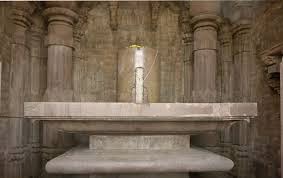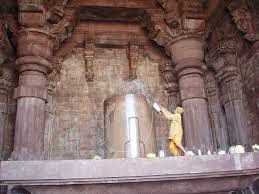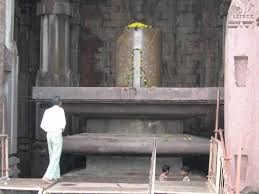पृथ्वीनाथ मंदिर | Prithvinath Temple – Prithvi Nath Temple Gonda
 भारत के उत्तर प्रदेश में खरगूपुर(गोण्डा) में स्थित है भगवान शिव को
समर्पित यह पृथ्वीनाथ मंदिर एक अति प्राचीन मंदिर है जो भारत के पौराणिक
काल से जुड़ा माना जाता है. हिंदुओं के प्रमुख धर्मिक स्थलों में से एक यह
स्थल शैव भक्तों का भी महत्वपूर्ण स्थान है. भगवान शिव के इस मन्दिर में एक
विशाल शिवलिंग स्थापित है. जिसके दर्शनों के के लिए भक्त देश के कोने कोने
से यहाँ पहुँचते है.
भारत के उत्तर प्रदेश में खरगूपुर(गोण्डा) में स्थित है भगवान शिव को
समर्पित यह पृथ्वीनाथ मंदिर एक अति प्राचीन मंदिर है जो भारत के पौराणिक
काल से जुड़ा माना जाता है. हिंदुओं के प्रमुख धर्मिक स्थलों में से एक यह
स्थल शैव भक्तों का भी महत्वपूर्ण स्थान है. भगवान शिव के इस मन्दिर में एक
विशाल शिवलिंग स्थापित है. जिसके दर्शनों के के लिए भक्त देश के कोने कोने
से यहाँ पहुँचते है.हजारों श्रद्धालु प्रतिदिन इस विशाल शिवलिंग का जलाभिषेक करके भगवान शिव का आशीर्वाद ग्रहण करते हैं. माना जाता है की अज्ञातवास के समय पाण्डवों ने यहाँ शिवलिंग की स्थापना की जिसमें यहां पांडवों ने भगवान शिव की पूजा-अर्चना की. तथा सभी ने अलग-अलग स्थानों पर शिवलिंग स्थापित किए ओर यहाँ का शिवलिंग भीम द्वारा स्थापित किया गया था.
पृथ्वीनाथ मंदिर पौराणिक कथा । Prithvinath Temple Story In Hindi
 पृथ्वीनाथ मंदिर के दर्शन पाकर सभी भक्त आत्मिक शांति को पाते हैं इस
शिवलिंग के दर्शन मात्र से ही सभी कष्ट, कलेश दूर हो जाते हैं भक्तों का
अटूट विश्वास इस स्थान की महत्ता को दर्शाता है मंदिर में हर समय ही भक्तों
की भारी भीड़ देखी जा सकती है. इस मंदिर के महत्व के बारे में एक पौराणिक
कथा प्रचलित है जिसमें कहा गया है की. जब पांडवों को अज्ञातवास मिला तो वह
यहां वहां अपने को छुपाते हुए घूम रहे थे.
पृथ्वीनाथ मंदिर के दर्शन पाकर सभी भक्त आत्मिक शांति को पाते हैं इस
शिवलिंग के दर्शन मात्र से ही सभी कष्ट, कलेश दूर हो जाते हैं भक्तों का
अटूट विश्वास इस स्थान की महत्ता को दर्शाता है मंदिर में हर समय ही भक्तों
की भारी भीड़ देखी जा सकती है. इस मंदिर के महत्व के बारे में एक पौराणिक
कथा प्रचलित है जिसमें कहा गया है की. जब पांडवों को अज्ञातवास मिला तो वह
यहां वहां अपने को छुपाते हुए घूम रहे थे.तब वह यहां पर आए इस दौरान भीम ने यहाँ पर इस शिवलिंग की स्थापना की थी. परंतु कालांतर में यह शिवलिंग जमीन में धसने लगा और धीरे धीरे पूरा का पूरा शिवलिंग धरती में समा गया कहा जाता है की एक बार खरगूपुर के राजा गुमान सिंह की अनुमति को पाकर गाँव के निवासी जिसका नाम पृथ्वी सिंह बताया जाता है, उसने अपना घर बनाने के लिए निर्माण कर्य शुरू करवाया परंतु जमीन की खुदाई के दौरान यहां से खून का फौव्वारा बहने लगा.
इस दृश्य को देखकर सभी लोग सहम गए तथा पृथ्वी नाथ सिंह ने घर का निर्माण कार्य को रोक दिया परंतु उसी रात में पृथ्वी सिंह को एक सपना आता है जिसमें उसे इस बात का पता चलता है कि भूमि के नीचे एक सात खण्डों का शिवलिंग दबा है हुआ है. जिसे निकाल कर उसकी स्थापना का आदेश प्राप्त होता है.
प्रात:काल उठ कर वह इस बात को राजा के समक्ष रखता है जिस पर राजा उस स्थान पर एक खण्ड तक शिवलिंग खोदने का निर्देश देता है और वहाँ से शिवलिंग प्राप्त होता है इस शिवलिंग की स्थापना की जाती है. राजा पूर्ण विधि विधान से शिवलिंग को मंदिर में स्थापित करवाता है तथा पृथ्वी के नाम पर इस मंदिर का नाम पृथ्वीनाथ शिव मन्दिर पड़ गया.
पृथ्वीनाथ मंदिर महत्व | Prithvinath Temple Importance
 पृथ्वीनाथ मंदिर के पौराणिक महत्व को देखते हुए लोगों की इसमें अपार
श्रद्धा देखी जा सकती है. मंदिर के दर्शन करने एवं शुद्ध मन से पूजा करने
से सभी पाप दूर हो जाते हैं व समस्त मनोकामनाएं पूर्ण होती हैं. मंदिर में
प्रति वर्ष महाशिवरात्रि के पावन समय बहुत बडे मेले का आयोजन किया जाता है
तथा शिवलिंग का महा अभिषेक होता है. इसके अतिरिक्त कजली तीज, जेठ दशहरे पर
लाखों श्रद्धालु देश भर से यहाँ पर आते हैं.
पृथ्वीनाथ मंदिर के पौराणिक महत्व को देखते हुए लोगों की इसमें अपार
श्रद्धा देखी जा सकती है. मंदिर के दर्शन करने एवं शुद्ध मन से पूजा करने
से सभी पाप दूर हो जाते हैं व समस्त मनोकामनाएं पूर्ण होती हैं. मंदिर में
प्रति वर्ष महाशिवरात्रि के पावन समय बहुत बडे मेले का आयोजन किया जाता है
तथा शिवलिंग का महा अभिषेक होता है. इसके अतिरिक्त कजली तीज, जेठ दशहरे पर
लाखों श्रद्धालु देश भर से यहाँ पर आते हैं.यह देश का सबसे बड़ा शिवलिंग माना जाता है जो महाभारत काल के समय का बताया जाता है. माना जाता है कि इस मंदिर में स्थापित शिवलिंग एशिया का सबसे बड़ा शिवलिंग है. विद्वानों का तर्क भी यही है कि यह शिवलिंग एशिया का सबसे बदा शिवलिंग है तथा नेपाल स्थित पशुपतिनाथ मंदिर में स्थापित शिवलिंग भी इतना बडा नही है.





 var vglnk = { key: '7b97ff3421e492f472158d5e101b45d4' };
(function(d, t) {
var s = d.createElement(t); s.type = 'text/javascript'; s.async = true;
s.src = '//cdn.viglink.com/api/vglnk.js';
var r = d.getElementsByTagName(t)[0]; r.parentNode.insertBefore(s, r);
}(document, 'script'));
/>
var vglnk = { key: '7b97ff3421e492f472158d5e101b45d4' };
(function(d, t) {
var s = d.createElement(t); s.type = 'text/javascript'; s.async = true;
s.src = '//cdn.viglink.com/api/vglnk.js';
var r = d.getElementsByTagName(t)[0]; r.parentNode.insertBefore(s, r);
}(document, 'script'));
/>